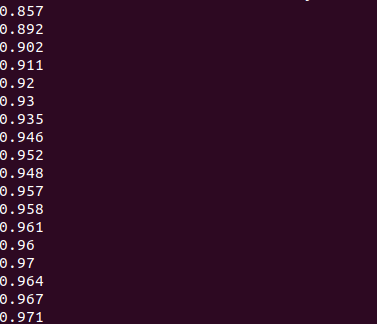TensorFlow从入门到理解(三):你的第一个卷积神经网络(CNN)
运行代码:
from __future__ import print_function
import tensorflow as tf
from tensorflow.examples.tutorials.mnist import input_data
# number 1 to 10 data
mnist = input_data.read_data_sets('MNIST_data', one_hot=True) def compute_accuracy(v_xs, v_ys):
global prediction
y_pre = sess.run(prediction, feed_dict={xs: v_xs, keep_prob: 1})
correct_prediction = tf.equal(tf.argmax(y_pre,1), tf.argmax(v_ys,1))
accuracy = tf.reduce_mean(tf.cast(correct_prediction, tf.float32))
result = sess.run(accuracy, feed_dict={xs: v_xs, ys: v_ys, keep_prob: 1})
return result def weight_variable(shape):
initial = tf.truncated_normal(shape, stddev=0.1)
return tf.Variable(initial) def bias_variable(shape):
initial = tf.constant(0.1, shape=shape)
return tf.Variable(initial) def conv2d(x, W):
# stride [1, x_movement, y_movement, 1]
# Must have strides[0] = strides[3] = 1
return tf.nn.conv2d(x, W, strides=[1, 1, 1, 1], padding='SAME') def max_pool_2x2(x):
# stride [1, x_movement, y_movement, 1]
return tf.nn.max_pool(x, ksize=[1,2,2,1], strides=[1,2,2,1], padding='SAME') # define placeholder for inputs to network
xs = tf.placeholder(tf.float32, [None, 784])/255. # 28x28
ys = tf.placeholder(tf.float32, [None, 10])
keep_prob = tf.placeholder(tf.float32)
x_image = tf.reshape(xs, [-1, 28, 28, 1])
# print(x_image.shape) # [n_samples, 28,28,1] ## conv1 layer ##
W_conv1 = weight_variable([5,5, 1,32]) # patch 5x5, in size 1, out size 32
b_conv1 = bias_variable([32])
h_conv1 = tf.nn.relu(conv2d(x_image, W_conv1) + b_conv1) # output size 28x28x32
h_pool1 = max_pool_2x2(h_conv1) # output size 14x14x32 ## conv2 layer ##
W_conv2 = weight_variable([5,5, 32, 64]) # patch 5x5, in size 32, out size 64
b_conv2 = bias_variable([64])
h_conv2 = tf.nn.relu(conv2d(h_pool1, W_conv2) + b_conv2) # output size 14x14x64
h_pool2 = max_pool_2x2(h_conv2) # output size 7x7x64 ## fc1 layer ##
W_fc1 = weight_variable([7*7*64, 1024])
b_fc1 = bias_variable([1024])
# [n_samples, 7, 7, 64] ->> [n_samples, 7*7*64]
h_pool2_flat = tf.reshape(h_pool2, [-1, 7*7*64])
h_fc1 = tf.nn.relu(tf.matmul(h_pool2_flat, W_fc1) + b_fc1)
h_fc1_drop = tf.nn.dropout(h_fc1, keep_prob) ## fc2 layer ##
W_fc2 = weight_variable([1024, 10])
b_fc2 = bias_variable([10])
prediction = tf.nn.softmax(tf.matmul(h_fc1_drop, W_fc2) + b_fc2) # the error between prediction and real data
cross_entropy = tf.reduce_mean(-tf.reduce_sum(ys * tf.log(prediction),reduction_indices=[1]))
train_step = tf.train.AdamOptimizer(1e-4).minimize(cross_entropy) sess = tf.Session()
# important step
init = tf.global_variables_initializer()
sess.run(init) for i in range(1000):
batch_xs, batch_ys = mnist.train.next_batch(100)
sess.run(train_step, feed_dict={xs: batch_xs, ys: batch_ys, keep_prob: 0.5})
if i % 50 == 0:
print(compute_accuracy(
mnist.test.images[:1000], mnist.test.labels[:1000]))
运行结果(本人电脑太差,准确度出现了下滑的问题):

TensorFlow从入门到理解(三):你的第一个卷积神经网络(CNN)的更多相关文章
- TensorFlow从入门到理解
一.<莫烦Python>学习笔记: TensorFlow从入门到理解(一):搭建开发环境[基于Ubuntu18.04] TensorFlow从入门到理解(二):你的第一个神经网络 Tens ...
- 卷积神经网络(CNN)学习笔记1:基础入门
卷积神经网络(CNN)学习笔记1:基础入门 Posted on 2016-03-01 | In Machine Learning | 9 Comments | 14935 Vie ...
- 深度学习之卷积神经网络CNN及tensorflow代码实例
深度学习之卷积神经网络CNN及tensorflow代码实例 什么是卷积? 卷积的定义 从数学上讲,卷积就是一种运算,是我们学习高等数学之后,新接触的一种运算,因为涉及到积分.级数,所以看起来觉得很复杂 ...
- 深度学习之卷积神经网络CNN及tensorflow代码实现示例
深度学习之卷积神经网络CNN及tensorflow代码实现示例 2017年05月01日 13:28:21 cxmscb 阅读数 151413更多 分类专栏: 机器学习 深度学习 机器学习 版权声明 ...
- 卷积神经网络CNN原理以及TensorFlow实现
在知乎上看到一段介绍卷积神经网络的文章,感觉讲的特别直观明了,我整理了一下.首先介绍原理部分. [透析] 卷积神经网络CNN究竟是怎样一步一步工作的? 通过一个图像分类问题介绍卷积神经网络是如何工作的 ...
- TensorFlow 2.0 深度学习实战 —— 浅谈卷积神经网络 CNN
前言 上一章为大家介绍过深度学习的基础和多层感知机 MLP 的应用,本章开始将深入讲解卷积神经网络的实用场景.卷积神经网络 CNN(Convolutional Neural Networks,Conv ...
- 【原创 深度学习与TensorFlow 动手实践系列 - 4】第四课:卷积神经网络 - 高级篇
[原创 深度学习与TensorFlow 动手实践系列 - 4]第四课:卷积神经网络 - 高级篇 提纲: 1. AlexNet:现代神经网络起源 2. VGG:AlexNet增强版 3. GoogleN ...
- TensorFlow从1到2(三)数据预处理和卷积神经网络
数据集及预处理 从这个例子开始,相当比例的代码都来自于官方新版文档的示例.开始的几个还好,但随后的程序都将需要大量的算力支持.Google Colab是一个非常棒的云端实验室,提供含有TPU/GPU支 ...
- 深度学习:Keras入门(二)之卷积神经网络(CNN)
说明:这篇文章需要有一些相关的基础知识,否则看起来可能比较吃力. 1.卷积与神经元 1.1 什么是卷积? 简单来说,卷积(或内积)就是一种先把对应位置相乘然后再把结果相加的运算.(具体含义或者数学公式 ...
- 深度学习:Keras入门(二)之卷积神经网络(CNN)【转】
本文转载自:https://www.cnblogs.com/lc1217/p/7324935.html 说明:这篇文章需要有一些相关的基础知识,否则看起来可能比较吃力. 1.卷积与神经元 1.1 什么 ...
随机推荐
- 关于PHP的 PHP-FPM进程CPU 100%的一些原因分析和解决方案
之前碰到过php-fpmCPU高达80%-90%,特此记录下 1. 查看是否是硬件问题 方式:top 命令 主要查看:load average(平均负载),这是一个4核8G内存的服务器 1分钟平均负 ...
- Minieye杯第十五届华中科技大学程序设计邀请赛网络赛 部分题目
链接:https://pan.baidu.com/s/12gSzPHEgSNbT5Dl2QqDNpA 提取码:fw39 复制这段内容后打开百度网盘手机App,操作更方便哦 D Grid #inc ...
- python操作excel文件一(xlrd读取文件)
一般做接口测试,会把参数和一些数据放入excel表中,这样就不会重新编译代码,提高效率.一般如何操作呢?接下来跟着步骤一起学习吧 执行步骤: 1.首先要安装 xlrd这个模块,用 pip instal ...
- 类图uml
画类图或时序的软件类图astah-community-6_9_0-b4c6e9-jre-setup 先写总体架构再写流程图 即先写类图再流程图 b ^ | a a继承b 工具类是us ...
- CentOS Bash 命令补全增强软件包 bash-completion
引言 之前安装的 CentOS 7 是最小化安装,在使用 systemctl 命令进行服务的管理时,经常手动输入相关服务名.如果对一个服务名称不熟悉,这样可以迫使我们记住它,但如果对一个服务名已经很熟 ...
- java将long数据转为int类型的方法
二.调用intValue()方法 [java] long ll = 300000; int ii= new Long(ll).intValue(); 三.先把long转换成字符串String,然后在转 ...
- golang 使用os/exec配合context实现的超时机制
在使用golang开发中,调用外部可执行程序通过exec包是我们常用的方式.如何控制超时请见如下样例: var ( Timeout = 3 * time.Second ) func Command(n ...
- python静态方法和类方法
静态方法和类方法在python2.2中被引用,经典类和新式类都可以使用.同时,一对内建函数:staticmethod和classmethod被引入,用来转化类中某一方法为这两种方法之一. 静态方法: ...
- Centos 6\7下yum安装rstudio-server\shiny-server
rstudio-server安装 #wget https://download2.rstudio.org/rstudio-server-rhel-1.1.463-x86_64.rpm #yum ins ...
- centos之Too many open files问题-修改linux最大文件句柄数
linux服务器大并发调优时,往往需要预先调优linux参数,其中修改linux最大文件句柄数是最常修改的参数之一. 在linux中执行ulimit -a 即可查询linux相关的参数,如下所示: [ ...
